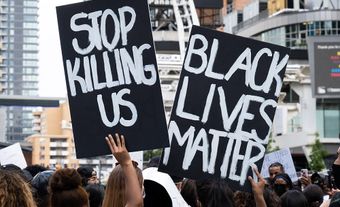Black people have been in Canada since the early 17th century (see Black Canadians). Throughout their 400-year history in Canada, Black people have faced racism, discrimination and hostility based on the colour of their skin. Anti-Black racism refers to attitudes, beliefs, stereotyping, discrimination and prejudice targeted at people of African descent. The roots of anti-Black racism are found in enslavement and its legacies. Deeply entrenched in Canadian institutions, policies and practices, anti-Black racism is either normalized or rendered invisible to the larger white society. Anti-Black racism manifests itself in how Black Canadians are disadvantaged, or marginalized, in society, the economy and politics. As a result, Black Canadians often have unequal opportunities, higher unemployment and significant poverty rates. They are also overrepresented in the criminal justice system (see also Criminal Code of Canada).
Anti-Black racism has manifested itself through various historical examples, including enslavement (the transatlantic slave trade) and segregation. Ongoing issues of anti-Black racism, such as police brutality and racial microaggressions, continue to persist in Canada.
Black Enslavement in Canada
The historical roots of anti-Black racism started with the transatlantic slave trade. The slave trade depended on the buying and selling of Africans for use as enslaved labourers. Traders of enslaved people exploited and profited from Africans’ labour. From the 16th to 19th centuries, the slave trade transported between 10 and 12 million people between Africa, the Caribbean, the Americas and Europe.
In colonial Canada, the enslavement of African people was a legal tool for economic interests. In New France, French colonizers started the practice of chattel slavery, in which enslaved African and Indigenous people were treated as personal property that could be bought, sold, inherited and traded. The practice of slavery continued after the Conquest of New France. The number of enslaved African people increased significantly in British North America after the American Revolutionary War (1775–83). (See American Revolution – Invasion of Canada.) White American Loyalists were encouraged to move north to Canada after the American Revolution. Many United Empire Loyalists brought along their “property” with them, including enslaved Black people. French and British colonists relied on Black people’s slave labour to build their personal wealth as well as the colonial economies. Thus, the intention of enslaving Black and Indigenous people was to exploit them for their labour. (See Black Enslavement in Canada; Enslavement of Indigenous People in Canada.)
Segregation
The racial segregation of Black people is evident throughout Canadian history. Racial segregation seeks to separate people and communities based on their race. Many Black people in Canada were segregated, excluded from or denied equal access to various opportunities and services. This was the case in education (see Racial Segregation of Black Students in Canadian Schools), employment, housing, immigration, transportation, military service (see Canadian Armed Forces) and healthcare. Historically, various laws, court decisions and societal norms upheld the racial segregation of Black people. To many, widely held beliefs about Black people’s racial inferiority (see Racism) during the period of enslavement justified racial segregation. Racial segregation against Black people in Canada was different in each province and territory, as well as in various communities.
Did you know?
In the late 19th and early 20th centuries, the Canadian government implemented several immigration policies to exclude Black people. Order-in-Council P.C. 1911-1324 was one such policy. It proposed to restrict and ban Black immigration to Canada. Policymakers believed that Black people were unsuited to Canada’s cold climate. Although the Order-in-Council never went into effect and was repealed, it demonstrated that Black immigrants were not wanted nor welcomed in Canada.
Contemporary Examples of Anti-Black Racism
Anti-Black racism continues against Black people in Canada today through a variety of overt and subtle dynamics. Some of these factors include education, poverty, the labour market, the justice system, immigration and housing. Unequal opportunities in education seriously impact Black Canadians in negative and discriminatory ways. In comparison to other youth, Black young people are less likely to attend post-secondary institutions and earn post-secondary qualifications. (See also Universities in Canada.) Although the socio-economic conditions of Black Canadians may vary according to their gender, region of origin or ancestry and generation status, discrimination and racism still exist and negatively impact Black people in Canada.
One subtle way that racism and discrimination are perpetrated is through racial microaggressions. Microaggressions are everyday insults, indignities and demeaning messages directed toward Black, Indigenous or racialized people by white people. The latter may be unaware or ignorant of the harmful and negative effects of these verbal aggressions. Examples of racial microaggressions would be someone saying “You don’t act like a normal Black person” and “You’re really pretty for someone so dark.” Racial microaggressions may stem from unconscious biases. They also demonstrate how racialized people are viewed by others. Racial microaggressions can be harmful to Black, Indigenous and racialized people. Racial microaggressions can leave targeted people feeling sad, excluded and viewed as second-class citizens.
Another way in which anti-Black racism manifests itself against Black people in Canada is through instances of police brutality. In Canada, Black and Indigenous people are overrepresented in police-involved deaths. In 2018, the Ontario Human Rights Commission found that, between 2013 and 2017, a Black person was nearly 20 times more likely to be shot and killed by the police in Toronto compared to a white person. Advocates argue that police brutality is just one of many symptoms of systemic racism found in Canada. Dismantling police brutality and injustice toward Black, Indigenous and racialized people in Canada need to be dealt with at the foundational level. For activists, this means addressing racism on a structural level and throughout society.

 Share on Facebook
Share on Facebook Share on X
Share on X Share by Email
Share by Email Share on Google Classroom
Share on Google Classroom



